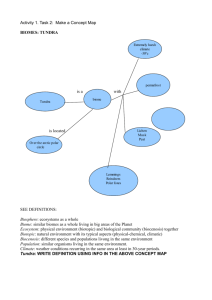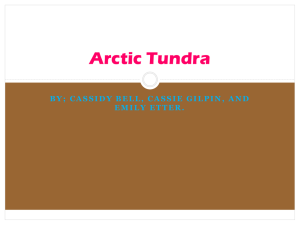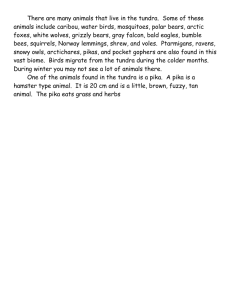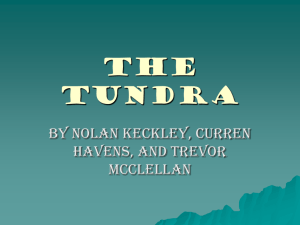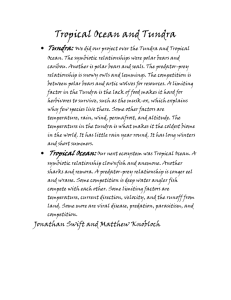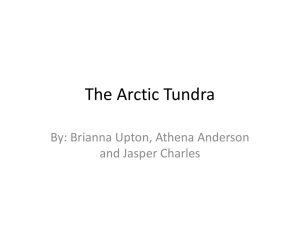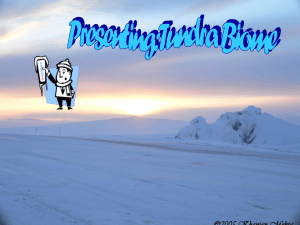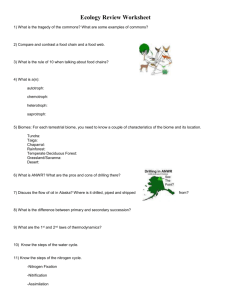Tundra
advertisement
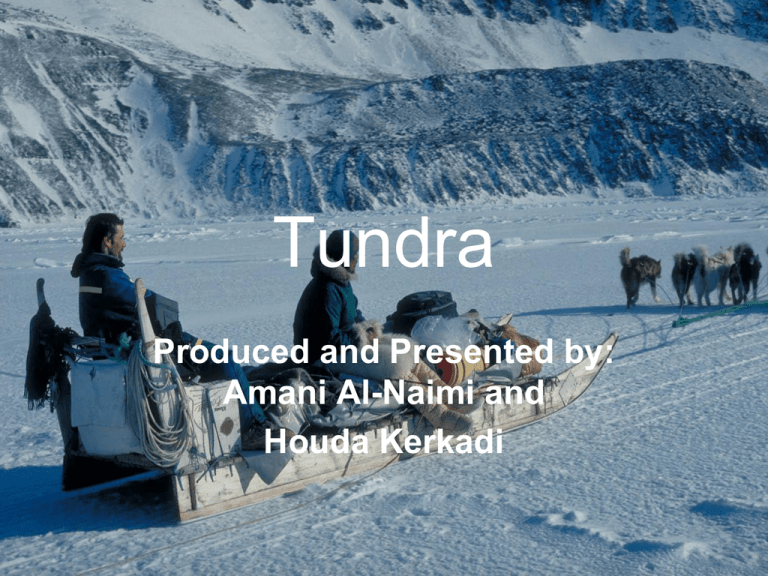
Tundra Produced and Presented by: Amani Al-Naimi and Houda Kerkadi Location The Tundra Is on top of North America ,Europe , and Asia . The Tundra Covers 1/10 of the world . What is the Tundra? • Tundra means upland, treeless and mountain tract. • There are 3 types of Tundra. • Arctic Tundra • Alpine Tundra • Antarctic Tundra • The Meaning of tundra: A treeless area between the icecap and the tree line of Arctic section. Animals of the Tundra Name:Alopex lagopus or Arctic Fox How this animal adapts: growing long fur that camouflages. tends to eat whatever is available the environment around them. It s movements are stealthy due to need of snow on the tundra. Its legs, ears and muzzle are short to save heat Name: Nyctea scandiaca or the snowy owl How does this animal adapt: Their wings they push around them they bring about all the heat out Live in nests and under the snow so they have less chance of getting eaten. Name: Oomingmak or the musk ox Name:Sea Bear or Ursus How does this animal adapt: Maritimus How does this animal adapt: one is that the hooves are capable of breaking ice so the oxen can drink during winter when the lakes are frozen thick fur insulates to keep oxen warm. eyes are adapted to see in really bright lights or really dark the horns warn off predators. How this animal adapts: Thick layer of blubber that is 4.5 inches deep Empty gleams of their hair provide them an outstanding filling Ears and tail are short so they don’t lose any heat. Plants of the tundra •.Arctic Moss- Arctic Moss can grow under fresh water that is left on the surface of the tundra after the summer •Arctic Willow- Arctic Willow is small and develops like a carpet on the land to be protected from the wind and be near the dirt, which gets warm in the sunlight. •Bearberry-Since bearberry is a low increasing plant it can stay out of the wind chill. •Labrador Tea-They have adapted so that photosynthesis (getting food from sunlight) can take place in the low light and cold temperatures. Weather in the Tundra ‘Summer Temperatures are 3- 12 Celsius Winter temperatures are -30 Fahrenheit through most of the arctic tundra In January they increase to -40 Fahrenheit and now they reached to -93 Fahrenheit Rainfall in Tundra • In the tundra there is not enough rainfall not enough to keep the plants living in the summer • There is about only 6-10 inches per year in the Arctic tundra that also includes the snow melt Killing the animals to get food and clothes • There is only about 1000 tigers in the world today • There is only about 20,000 polar bears but coming to the thought that we as humans are 6 billion! Eskimos used to kill these rare animals in order to het enough food and warm clothes to survive in. The care that some people do to animals and plants • Eskimo’s take care of animals that are wild or there mother was captured or killed • They use the animals as a way to fish if their not able to. • Some Eskimo's they go and some times take care of the plants that are there because they will not see plants this rare for a long time Arctic Tundra • Arctic Tundra occurs in Northern Hemisphere. • It is A big area of stark landscape. • Frozen for much of a year • Impossible for trees to grow • Rocky land can only support low growing plants .Such as moss, crow berry, and blackberry. • Winter-28 °C • Summer-12 °C Antarctic Tundra • Occurs on Antarctica • Too cold Dry to make food • Have areas of rocky soil that support plant life. Alpine Tundra • Alpine tundra does not contain any sort of trees . • Alpine tundra occurs in mountains worldwide. • The Alpine Tundra is not like other biomes. This biome can be found at any latitude on earth Bibliography • • • "Dictionary of Plant Adaptation." Greenwich Public Schools. Web. 21 Mar. 2010. <http://www.greenwichschools.org/page.cfm?p=3616#C>. "Google Image Result for Http://1.bp.blogspot.com/_iiIEFwh9eU/R4kCEQxUr1I/AAAAAAAAAKo/BQSbC1y3ov8/s320/tundra4865.JPG." Google Images. Web. 21 Mar. 2010. <http://images.google.com/imgres?imgurl=http://1.bp.blogspot.com/_iiIEFwh9eU/R4kCEQxUr1I/AAAAAAAAAKo/BQSbC1y3ov8/s320/tundra4865.JPG&imgrefurl=http:// foothillsfancies.blogspot.com/2008/01/neversummer.html&usg=__9Yj9wvYQPKiw6zbJAQJs_gu2zoE=&h=320&w=264&sz=29&hl=en&start=2 &itbs=1&tbnid=0jB0R6lEIaIvkM:&tbnh=118&tbnw=97&prev=/images%3Fq%3Dsummer%2Bin%2 Bthe%2Btundra%26hl%3Den%26safe%3Dactive%26gbv%3D2%26tbs%3Disch:1>. "Google Image Result for Http://farm1.static.flickr.com/105/267247080_99f52bd44e.jpg." Google Images. Web. 21 Mar. 2010. <http://images.google.com/imgres?imgurl=http://farm1.static.flickr.com/105/267247080_99f52bd4 4e.jpg&imgrefurl=http://biomesarebest.blogspot.com/&usg=__jVHz54DFSxulH0dB51G5dEQ9C6c =&h=500&w=314&sz=194&hl=en&start=19&itbs=1&tbnid=5Ek0gUvx8BFqKM:&tbnh=130&tbnw=8 2&prev=/images%3Fq%3Darctic%2Bmoss%2Bin%2Bthe%2Btundra%26hl%3Den%26safe%3Da ctive%26gbv%3D2%26tbs%3Disch:1>. • • • • • • • "Google Image Result for Http://users.iab.uaf.edu/~emily_weiser/pics Landscapes, Flowers, Camp/ArcticWillow.jpg." Google Images. Web. 21 Mar. 2010. <http://images.google.com/imgres?imgurl=http://users.iab.uaf.edu/~emily_weiser/pics%2520landsc apes,%2520flowers,%2520camp/ArcticWillow.jpg&imgrefurl=http://users.iab.uaf.edu/~emily_weiser /aboutNS.html&usg=__pglW6L1DoQM0wOJ1BTTZoaJEUQ=&h=432&w=333&sz=26&hl=en&start=2&itbs=1&tbnid=y2pwBukL3_ qMnM:&tbnh=126&tbnw=97&prev=/images%3Fq%3Darctic%2Bwillow%26hl%3Den%26safe%3Da ctive%26gbv%3D2%26tbs%3Disch:1>. "Google Image Result for Http://www.aktrekking.com/pebble/48-Bearberry_plants_copy.jpg." Google Images. Web. 21 Mar. 2010. <http://images.google.com/imgres?imgurl=http://www.aktrekking.com/pebble/48Bearberry_plants_copy.jpg&imgrefurl=http://www.aktrekking.com/pebble/MineSite/MineSitePhotos. html&usg=__6Fx_i_GVcya8O_s9WWggS3R2Eq8=&h=284&w=300&sz=65&hl=en&start=9&itbs=1 &tbnid=1D5ABiQ0tWwEYM:&tbnh=110&tbnw=116&prev=/images%3Fq%3Dtundra%2Bbearberry %2Bplant%26hl%3Den%26safe%3Dactive%26gbv%3D2%26tbs%3Disch:1>. "Summer Temperatures in Tundra - Search." Google. Web. 21 Mar. 2010. <http://www.google.com/search?hl=en&safe=active&rlz=1R2ADSA_enQA368&nfpr=1&ei=UUumS 7byDIu8rAen2pHSCA&sa=X&oi=spell_nofullpage&resnum=0&ct=result&cd=1&ved=0CAUQBSgA &q=summer+temperatures+in+tundra&spell=1&safe=active>. "Tundra -." Wikipedia, the Free Encyclopedia. Web. 21 Mar. 2010. <http://en.wikipedia.org/wiki/Tundra>. "Tundra in the Map - Search." Google. Web. 21 Mar. 2010. <http://www.google.com.qa/search?hl=en&source=hp&q=Tundra+in+the+map&meta=&rlz=1R2AD FA_enQA337&aq=f&aqi=&aql=&oq=&gs_rfai=&emsg=NCSR&ei=i-ikS5yCoTGrAfH6fHBCA&safe=active>. "WikiAnswers - What Is a Musk Ox's Adaptations." WikiAnswers - The Q&A Wiki. Web. 21 Mar. 2010. <http://wiki.answers.com/Q/What_is_a_musk_ox's_adaptations>. Windows to the Universe. Web. 21 Mar. 2010. <http://www.windows.ucar.edu/tour/link=/earth/images/biomes_map_big_jpg_image.html&portal=c mmap>. Credits • Farrah-Lilia Kerkadi • Mr. Noushal Amani’s Tutor
